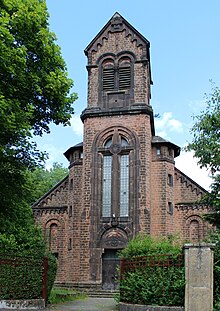St. Ludwig (Friedrichsthal)
St. Ludwig is a Catholic church on Straße des 25. Oktober in the Friedrichsthal district of Maybach . As part of the “Grube und Siedlung Maybach” monument ensemble, it is a listed building.
history
After the Maybach mine was established in the western municipality of Friedrichsthals in 1873 , the Prussian mining treasury set up its own settlement in the immediate vicinity of the mine from 1900. The new district was cared for in pastoral care from Friedrichsthal. In 1910 the parish of Friedrichsthal was divided, the previous branch of the wayside shrine was elevated to a chapel parish and became independent from 1913. After the First World War , the Saarland mines were taken over by the French mine administration and so numerous French mine officials and employees came to Maybach. Due to the flourishing coal industry, the number of workers in the mine had already grown strongly, so that in 1924 there were 54 Catholic families with 211 members.
Since the way to the church in Bildstock was long and difficult, especially in winter, the wish was expressed in the early 1920s to have their own church in Maybach. The mine administration wanted to serve the interests of its workers, employees and officials and commissioned the French architect Schalmeaux with the plan for a small church, which was originally to be built on public land above the mine. Since they wanted to keep the church in mine ownership, it was decided to build the building on the pit floor and opted for a piece of land below the school that had been leased permanently from the forestry treasury. The church received the patronage of the French national saint St. Ludwig . The foundation stone was laid on September 18, 1924, and the priest's blessing took place on Christmas Eve 1925. One day later the first high mass was held.
In 1942 the parish of Bildstock acquired the church and on February 1st a chaplain moved to Maybach. Two years later, Maybach was even raised to the position of Expositur and thus an independent pastoral care district. In 1949 the once splendidly painted church was renovated: the old plaster was removed, a coarse spray plaster applied and the furnishings renewed. In 1953 pews were purchased and a year later the church received a new organ.
After the departure of Expositus Paul Ständebach in 1950, Maybach no longer received a new pastor, but was looked after by the wayside shrine. Since the merger of the parishes of Friedrichsthal and Bildstock, the church has again been looked after by the parish of Friedrichsthal. The sacred building is no longer used for church services today. Only the annual commemoration of the mine disaster on October 25, 1930 still takes place in the church.
Architecture and equipment
The broken stone church was built in the shape of a basilica in neo-Romanesque style . A square tower with an entrance portal was placed in front of the rectangular hall with a small apse . The church tower is flanked by two smaller turrets. Above the entrance portal with an abstractly decorated tympanum sits a raised window with a mighty cross. The facade is lavishly decorated with pilaster strips and arched friezes.
Before the church was renovated in 1949, the walls of the apse and hall were richly painted. During the renovation, the old plaster was removed and replaced by a spray plaster that has been preserved to this day. The wooden pulpit, candlesticks and neo-Gothic high altar have also been removed. The Saarbrücken artist Günther Maas created a simple altar with a large wooden cross, a wrought iron communion bench , a new pulpit and a statue of the Virgin Mary. The unadorned wooden benches were purchased in 1954.
The windows of the apse are kept in shades of blue, the rest are colorless.
organ
St. Ludwig houses an organ with 13 registers on a cone store , which was built in 1954/55 by Hugo Mayer Orgelbau from Heusweiler . The stop action is electric, the game action is electro-pneumatic. The disposition is as follows:
|
|
|
||||||||||||||||||||||||||||||||||||||||||||||||
- Coupling : II / I, I / P, II / P
- Playing aids : 1 free combination, crescendo roller
literature
Werner Klär: The Church of St. Ludwig in Maybach . In: Friedrichsthaler Hefte , No. 6, 1980, pp. 269-275
Web links
- St. Ludwig at the parish of Friedrichsthal
Individual evidence
- ↑ Sub-monument list of the Saarbrücken regional association ( Memento of the original from January 7, 2014 in the Internet Archive ) Info: The archive link has been inserted automatically and has not yet been checked. Please check the original and archive link according to the instructions and then remove this notice. , List of monuments of the Saarland, Landesdenkmalamt Saar p. 3 (PDF)
- ↑ Werner Klär: The Church of St. Ludwig in Maybach . In: Friedrichsthal. A journey through time . City of Friedrichsthal, Friedrichsthal 1999, pp. 114–115
- ↑ The organ on OrganIndex
Coordinates: 49 ° 19 '31.9 " N , 7 ° 4' 12.8" E



